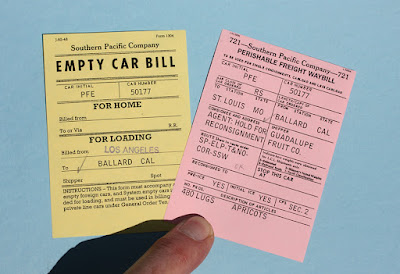Awhile back, when leafing through Ted Culotta’s excellent series, Focus on Freight Cars, I had one of those experiences where two entirely independent thoughts suddenly coalesce into something else, and I had an idea for a kitbash. I had recently noticed, as I do from time to time, that I had in my stash a couple of styrene 50-foot Viking roofs (I think from Des Plaines Hobbies), and that recollection surfaced when I looked at a photo in Ted’s Volume 5 (“Steel Automobile Cars”) and I suddenly focused on this image (page 77):
This car, a 1937-built automobile car, has a Viking roof and sharp-corner Dreadnaught ends. And I have some 50-foot Branchline box car bodies. Let’s see if I have the parts that can go together. Below are the intended parts: a Branchline D&TS body, the Viking roof resting in place, and the Cannonball Car Shops 4/5 sharp-corner ends, parts #31511 (styrene moldings made in the former Red Ball molds originally used for white metal castings). These all fit.
The decorated car body you see above is as it came from the box. My first step was to strip the paint, using an elderly bottle of ScaleCoat stripper that still has enough oomph for a job like this. Otherwise the somewhat thick white lettering can be physically if not visually evident through a coat of good model paint.
Next I added weight to the car, using 5/8-11 steel nuts, attached with canopy glue. These will bring the weight of the model toward the NMRA recommended weight for a 50-ft. car. Note also below that I have installed the underframe and coupler boxes, essential to be in place before attaching the ends.
My next step in a model like this is to attach the doors, which will greatly stiffen the car body. An advantage of doing so at this stage is that additional styrene cement can be applied inside the body to the door contacts with the car body. The doors in this kit happen to be post-war doors, but they at least resemble the pre-war doors on the prototype 1937-built automobile car. The model thus shades toward a stand-in for the CNW prototype.
The stand-in nature of the project is amplified by the side-sheet patterns. The 1937 prototype has four side sheets to the left of the doors, six to the right, called a 4-6 pattern. The Branchline postwar body has the pattern typical of later cars, a 5-8 pattern. But in HO scale, side sheets aren’t very visible, so I chose to let this go.
Here is the model at this stage, ready for installation of the Viking roof.
My next steps will be to add the roof and ends. The Cannonball Car Shops ends are the correct sharp-corner “original” Dreadnaught style, but will require some trimming and fitting to line up properly with the roof and underframe. I will illustrate those steps in a future post.
Tony Thompson













































